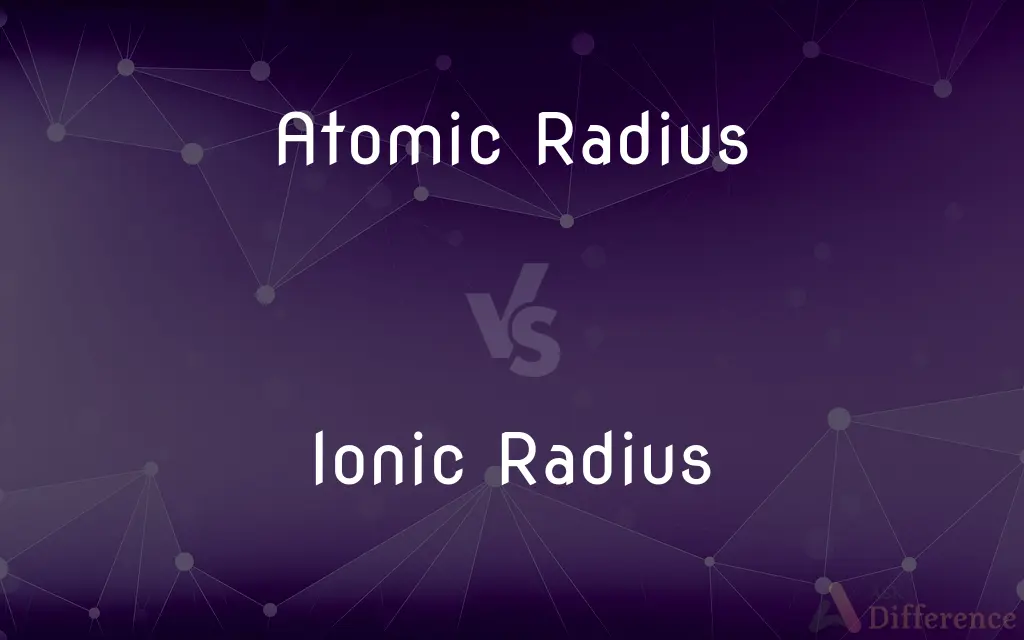Atomic Radius vs. Ionic Radius — What's the Difference?
By Tayyaba Rehman — Published on January 10, 2024
Atomic radius refers to the size of a neutral atom, while ionic radius is the size of an atom's ion.

Difference Between Atomic Radius and Ionic Radius
Table of Contents
ADVERTISEMENT
Key Differences
Atomic radius refers to the distance from the nucleus to the outer boundary of the electron cloud of a neutral atom. Ionic radius, on the other hand, pertains to the size of an ion, which can be an atom that has lost or gained electrons.
In atomic radius, the measure can vary depending on the method used, such as van der Waals radius or covalent radius. Ionic radius is affected by the gain or loss of electrons; cations (positively charged) generally have smaller radii than the neutral atom, and anions (negatively charged) have larger radii.
The atomic radius of elements generally decreases across a period due to increased nuclear charge pulling electrons closer. In contrast, the ionic radius can increase or decrease based on the nature of the ion formed.
Atomic radius is influenced by both the number of electron shells and effective nuclear charge. The ionic radius is also influenced by these factors, in addition to the change in electron configuration upon ionization.
In a neutral atom, the atomic radius represents the overall size of the atom. The ionic radius represents the size of an ion, which may have a completely different electron configuration and hence a different size compared to the neutral atom.
ADVERTISEMENT
Comparison Chart
Definition
Size of a neutral atom.
Size of an atom's ion.
Influence of Electrons
Determined by neutral electron configuration.
Affected by gain or loss of electrons.
Trend Across Periods
Generally decreases across a period.
Can increase or decrease based on ion formation.
Trend Down Groups
Increases down a group.
Also increases, but varies with ion type.
Variation Among Isotopes
Can vary slightly.
More pronounced changes due to ionization.
Compare with Definitions
Atomic Radius
Measured to the edge of the electron cloud.
Atomic radius is affected by the number of electron shells.
Ionic Radius
Size of an atom's ion.
The ionic radius of Cl- is larger than its atomic radius.
Atomic Radius
Measurement of an element’s size.
The atomic radius of oxygen is 60 pm.
Ionic Radius
Influenced by changed electron configuration.
Ionic radius reflects the altered electron structure in ions.
Atomic Radius
Indicates trends across periods and groups.
Across a period, the atomic radius decreases.
Ionic Radius
Distinguishes between cation and anion sizes.
Cations typically have a smaller ionic radius compared to anions.
Atomic Radius
Represents the size of a neutral atom.
The atomic radius increases down the periodic table.
Ionic Radius
Affected by the ionization of an atom.
The ionic radius of Na+ is smaller than its atomic radius.
Atomic Radius
Distance from the nucleus to the outer boundary of the electron cloud.
The atomic radius of helium is smaller than that of neon.
Ionic Radius
Measurement of a charged atom’s size.
The ionic radius changes when an atom gains or loses electrons.
Common Curiosities
Why is Ionic Radius different from Atomic Radius?
Because ionization changes the number of electrons, altering the size.
Are cations smaller or larger in Ionic Radius?
Smaller, as they lose electrons and electron shells.
What is Atomic Radius?
The distance from the nucleus to the outer boundary of a neutral atom's electron cloud.
Is Ionic Radius important in crystal structure?
Yes, it influences the structure and properties of ionic compounds.
Does Atomic Radius increase down a group?
Yes, due to the addition of electron shells.
Does Atomic Radius indicate the exact boundary of an atom?
Not exactly, as electron clouds do not have a sharp boundary.
Why does Ionic Radius increase for anions?
Due to electron gain, which increases electron-electron repulsion.
What is Ionic Radius?
The size of an atom's ion, either after losing or gaining electrons.
How does Atomic Radius vary across a period?
It generally decreases due to increased nuclear charge.
Can Ionic Radius be larger than Atomic Radius?
Yes, especially for anions that have gained electrons.
Does Ionic Radius depend on coordination number?
Yes, it can vary with the coordination number in a crystal lattice.
Does Atomic Radius affect chemical reactivity?
To an extent, as it influences how atoms interact and bond.
Can isotopes have different Atomic Radii?
Slightly, due to differences in nuclear mass.
Are Atomic Radii consistent for all elements?
They vary widely across the periodic table.
How is Ionic Radius measured?
Typically through X-ray crystallography and other spectroscopic methods.
Share Your Discovery

Previous Comparison
Android Tv vs. Smart Tv
Next Comparison
Prop Root vs. Stilt RootAuthor Spotlight
Written by
Tayyaba RehmanTayyaba Rehman is a distinguished writer, currently serving as a primary contributor to askdifference.com. As a researcher in semantics and etymology, Tayyaba's passion for the complexity of languages and their distinctions has found a perfect home on the platform. Tayyaba delves into the intricacies of language, distinguishing between commonly confused words and phrases, thereby providing clarity for readers worldwide.
















































